Introduction
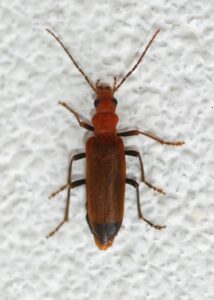
Wood-destroying organisms, other than termites (subterranean and non-subterranean) and rodents (explained in separate sections) cause great damage to wooden products and fixtures in homes, in addition to the inconvenience and anxiety caused by some of them to humans. The infestation of wood pests extends to all the wood of the house, starting with the wood used in the foundations of the house, ceilings, and wooden fixtures such as doors and windows, and then moving to wooden furniture of all kinds, frames, statues, and wooden trees in home gardens as well. Infestation with wood borers varies according to the type of wood (hard or soft), the composition of the product from original or manufactured wood (mixed with other materials or wood pulp), the age of the wood product, its location, and the materials treated with it such as dyes and adhesives, in addition to the type of pest itself, which differs in Their bio-capacity, food preference, environmental conditions affecting them, and control measures used. Infection of wood with pests causes it to be infected with wood rotting fungi (and vice versa) (dry or wet fungi), which increases the economic damage that occurs to the components and contents of the house. Among the most important pests that infest wood in homes are:
I – Carpender Ants (Family Formicidae: Order Hymenoptera)
Carpenter Ant – Camponotus spp. (Fabricius)
II – Carpenter Bees (Family Apidae: Order Hymenoptera)
Black Carpenter Bee – Xylocopa violacea Linnaeus
III – Beetles (Order Coleoptera)
- Anobiid Powderpost Beetles (Family Anobiidae)
A – Common Furniture Beetles or Common House Borer –
Anobium punctatum De Geer
B – Death Watch Beetles – Xestobium rufovillosum (De Geer)
- Bostrichid Powderpost Beetles (Family Bostrichidae)
Bamboo borer – Dinoderus minutus (Fabricius)
- Lyctid Powderpost Beetles (Family Lyctidae)
Brown Lyctus Beetle – Lyctus brunneus (Stephens)
- Old House Borers, Long-horned Beetles, or Round-Headed Beetles (Family Cerambycidae)
Old House Borer – Hylotrupes bajulus (Linnaeus)
- Big-Headed Border, or Metallic Wood Borers (Family Buprestidae)
Golden Jewel Beetle or Golden Buprestid – Buprestis aurulenta Linnaeus
- Wharf Border (Family Oedemeridae)
Wharf Borer or Pavement Borer – Nacerdes melanura (Linnaeus)
IV – Fungi
V – Rodents (Please link to rodent section)
I – Carpender Ant
General Description
| · There are 14 species of carpenter ants occurring in UAE. They have similar morphological characteristics. The more commonly associated with human habitation in UAE is Camponotus thoracicus (Fabricius)
· Carpenter ants have a one-segmented pedicel in the form of vertical scale. · Carpenter ant workers have a single segment or node on the pedicel. Also, the thorax appears evenly rounded in profile. · The queen size can range between 20-25 mm, medium worker size 7-12 mm, major worker 6-12 mm and males about 11 mm. · All castes have dark brown, black, and orange; except males they usually have dark brown color. Coloration alone is not a good character for identification as there are a number of non-carpenter ant species that have similar coloration as carpenter ant species.
|
Zach Lieberman / © AntWeb.org |
Life Cycle and Common Characteristics
- Carpenter ants apparently prefers dry habitats and colonies can be found under rocks, nesting under stone next to and under Acacia trees, in dry leaf litter next to a date palm tree
- In a large colony (i.e., 10,000 individuals), the queen can reach the age of 20 years.
- Carpenter ant colonies are initiated by a single queen, who begins a nest in a tree hole, in an insect-bored tunnel in a tree, or a similarly sequestered area in wood with sufficient moisture. The founding queen then lays a few eggs which hatch within 2-3 weeks.
- The first batch of workers is very small when they develop into adults and are known as minims. These workers begin to forage for food and water for the colony and also care for the young.
- A second clutch of eggs is not laid by the queen until the first clutch becomes adults and is able to care for them.
- The queen’s sole purpose from this point on is egg production.
- When a colony reaches a certain size, winged male and female reproductives, also known as swarmers, are produced.
- Female reproductives, which are prospective founding queens, are quite large in number of species, measuring 18 mm), while the males are smaller than 13 mm.
- Swarmers hatch into adults in late spring or early summer and stay within the colony, overwintering in the nest.
- Nuptial flights occur the following spring, from May to July. Males and females fly off from the nest in great numbers
- Mating occurs high in the air, with the male locating the female by pheromones. The male dies soon after mating and the inseminated queen lands, loses her wings, and begins the search for a suitable nesting site.
- The life cycle is estimated to be 6 to 12 weeks from egg to adult. In cold weather, the life cycle can stretch the development time up to 10 months.
Damage and Economic Implications
Damage to Wooden Structures
- Carpenter ants are considered some of the most serious pests to wood structures worldwide. They also nuisance pests.
- Carpenter ants enter to buildings to nest or They are called “carpenter” because they excavate their nests in wood, creating smooth tunnels and galleries (chewed out with their mandibles), and expand their nesting sites (preferably in dead, damp wood).
- They do not consume the wood (unlike termites), and sometimes, they hollow out sections of trees.
- They typically eat parts of other dead insects or substances derived from other insects. The also feed on honeydew produced by aphids. Their main food sources normally include proteins and carbohydrates.
- Most species of carpenter ants forage at night individually or in small or large groups.
|
A closeup of carpenter ant Credit: Nwbeeson
|
|
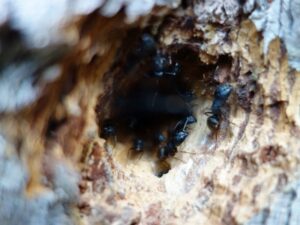
Carpenter ants in a tree Credit: NaCl58 |
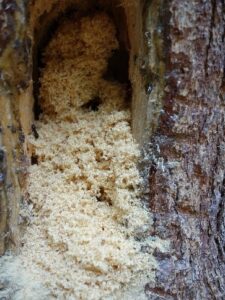
Sawdust like shavings from ants Credit: NaCl58 |
Biting People
- Carpenter ants bite when their nests are disturbed,
- The bite can be painful and potentially break the skin, this is because of their large size and powerful mandibles.
II – Black Carpender Bee
General Description

Credit: SeeSchloss |
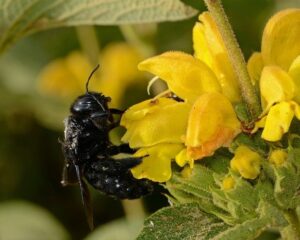
Credit: Gideon Pisanty |
- The carpenter bee is large and robust. Black in color and marked with areas of yellow hair, but the dorsal sides of the abdominal segments have no areas of yellow hair.
- Females grow up to 40 mm, black, with a metallic sheen.
- The thorax is covered with brown to black hair, and the upper side of the abdomen is glossy and bare.
- The female has a black head, and the male has white markings on the head. Dense brush of hairs on the hind legs.
Life Cycle and Common Characteristics
- The female uses her strong mandibles to excavate a clean-cut, round nest entrance hole (less than 10 mm wide) on the lateral surface of the wood in an exposed or unexposed location. They excavate the gallery at the rate of about 25mm in six days
- Tunnels are prepared by the female and eggs are laid in the spring.
- Larvae and pupae develop in the closed cells in early Summer.
- Adult bees emerge in late summer and return to the same tunnels to hibernate for the Winter months.
- In the spring, the adult mate, and the females lay eggs, completing the cycle.
- Carpenter bees complete one generation per year.
- Carpender bees are solitary insects that do not form colonies
Damage and Economic Implications
- Carpenter bees choose their nesting sites within buildings including siding, eaves, wooden shakes, porch ceilings, window sills and doors.
- They also nest in telephone poles, fence railings or posts, and even in lawn furniture.
- They prefer to nest in softwoods.
- Unpainted or well-weathered wood is much more susceptible to attack than hardwood or well-painted timbers.
III – Beetles
- Anobiid Powderpost Beetles:
A – Common Furniture Beetles or Common House Borers
General Description
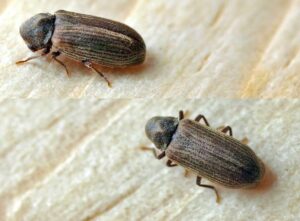
Credit: entomart |
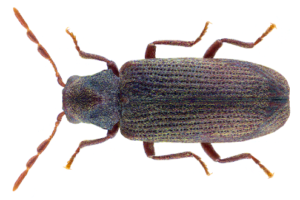
Credit: Udo Schmidt |
- They are also called common furniture wood beetles or woodworms.
- Adults are small, up to 3-6 mm in length. They are reddish-brown with dark spots along the dorsal stripes.
- The antenna has 11 segments and the last three segments are enlarged and elongated. These last three segments are longer than the other eight segments combined.
- The winged body is cylindrical and elongated in shape and covered in fine hair.
- Like most wood-boring larvae, furniture beetle larvae are creamy-white with dark brown mandibles. A double row of spines occurs on the dorsal side.
- The length of the larvae when fully developed is 6 mm. They are grub-like in appearance and C-shaped.
Life Cycle and Common Characteristics
- The beetles emerge from their hidden places or items in early summer and are seen crawling or flying indoors and are especially attracted to light.
- They are found mostly on floors, wooden beams, and furniture made of beech, pine, or oak.
- Adults mate and then females lay their eggs in cracks in the wood or inside old exit holes.
- Females don’t lay eggs on smooth surfaces, painted or stained wood, or even varnished wood. The female lays about 18 eggs, each up to 1 mm long.
- The eggs hatch after a period ranging from several days to a month, provided that the humidity is not less than 60%.
- The larvae bore in wood and feed upon it.
- Larvae pupate under the outer surface of the wood so that the adult insects can easily emerge.
- The adults then break through the surface, making a 1 mm to 1.5 mm exit hole and spilling dust, the first visible signs of an infestation.
- After adults emerge, they do not feed; they find mates, reproduce, and die.
- The life cycle is 3-5 years.
Damages and Economic Implications
- It causes severe damage to household wood. If heavy infestation occurs, you can find a pile of fresh wood-colored powder gathering underneath exit holes.
- We only see the damage of the beetle, because the adults only live for a short period of time and are active during the night.
- Adults spread increases as the water content of the wood increases or the relative air humidity increases.
B – Death Watch Beetles
General Description
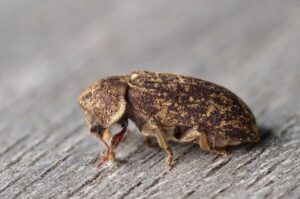
Adult Side View – Credit: Gilles San Martin |
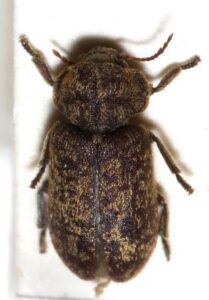
Adult Top View – Credit: Sarefo |
- The death watch beetle is small, 6-8 mm long, reddish-brown, with scale-like gray-yellow spots on its back.
- Eggs are 0.7 mm in length and 0.5 mm in width.
- The color of the larvae is creamy-white with six legs, black jaws, and the eyes consist of two visual spots on each side of the head (unlike the more familiar furniture wood beetles, in which the eyes consist of one visual spot on each side).
- The wing covers are without any rows of pits. The antennae are 11-segmented with the last three segments somewhat enlarged.
- Larvae grow to about 11 mm.
- The pupa, when newly formed, is shiny and milky white in color.
- The pupa measures 7–8 mm in length and around 3 mm in width.[1]
Life Cycle and Common Characteristics
- They are called death watch beetles because adults regularly bang their heads against the walls of the tunnels they excavate once every second as a way to attract the opposite sex to mate.
- Eggs are laid in dark crevices in old wood inside buildings, trees, and inside tunnels left behind by previous larvae.
- After egg hatching, the larvae bore into the timber by tunneling through them.
- Larvae feed for up to 10 years before pupating and later emerge from the wood the adults (in April, May, or June) as adult beetles.
- The life cycle takes 2-3 years and may extend to 10 years when the surrounding humidity is low.
Damage and Economic Implications
- Wood attacks old homes, especially where poor ventilation and high humidity often occur as a result of rainwater absorption.
- It infests wooden furniture, books, and dead trees, as it lives on vegetables and dry plants.
2 – Bostrichid Powderpost:
Bamboo borer
General Description
| · The bamboo borer is a very small beetle.
· The adult is dark reddish-brown, short, stout, cylindrical in shape, 3-4 mm long, and 1-1.5 mm wide. The pronotum is convex and a small part of the head is visible from above in front of the thorax. |
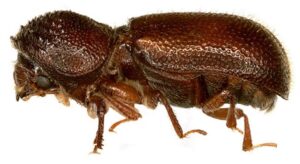
Credit: Wisut Sittichaya et al. |
The three-terminal segments of the adult antennae are swollen. The compound eyes are back and round. The antennae are ten-segmented and lamellate. The legs are reddish-brown.
- Eggs are spindle-shaped or elongate-oval, very small, milky-white, and nearly transparent. The eggs are individually laid in tunnels made by the adults.
- Larvae are approximately 3 to 4 mm long and milky white. The body is ‘C’-shaped. The head is round and the length is equal to the width. The mouthparts are black. The thorax is expanded and bears three legs, which decrease along its length. The spiracles are oval-round, which is longer than those in the sternum. Dense hair covers the tibia.
- Pupae are almost spindle-shaped, approximately 2.5 to 4 mm long, and milky white. The compound eye and mandibles are black.
Life Cycle and Common Characteristics
- The first peak of adult emergence is in February, the second is in June, and the third is in October. Both adults and larvae bore into the wood.
- The peak time for oviposition is in May and June.
- The female can lay about 20 eggs.
- The eggs hatch in 5 to 8 days.
- Larvae bore longitudinally and make a tunnel about 15 to 20 mm long.
- Larvae take about 40 days to develop.
- Pupation occurs in cocoons made at the terminal end of the larval tunnels.
- After approximately 4 days, the newly developed adult beetles may fly away or may explore other parts of the same bamboo.
- Starch, soluble carbohydrates, and proteins are nutritionally essential to bamboo borers.
- The life cycle from egg to adult completes in less than 2 months.
- Several generations each year.
Damages and Economic Implications
- The bamboo borers are the main pests of bamboo, attracted by the internal starch.
- They infest household furniture made of bamboo wood and turn the interior parts into a fine powder, which weakens them and makes the wood vulnerable to breakage.
- These borers also attack some stored foodstuffs such as spices, grains (corn, rice), flour, and other foods.
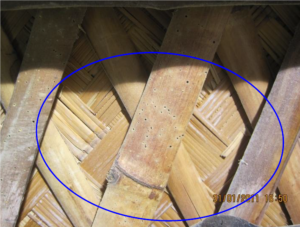
Extensive exit holes from Bamboo wood |
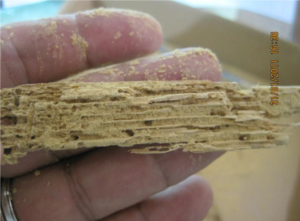
Damaged Bamboo wood infested with beetles
|
3 – Lyctid Powderpost Beetles:
Brown Lyctus Beetle
General Description
| · The adult is 2-6 mm long, rectangular, and brown in color. The color varies from light brown to reddish-brown. The whole head appears in front of the thorax from above. The antennae consist of 11 segments, and the two ends are swollen.
· The larvae are about 0.5 mm long, cream colored with brown heads and jaws, and three pairs of small jointed legs and straight-bodied but later become C-shaped. The respiratory stoma is on the eighth abdominal segment and is distinguished by its clarity and largeness compared to the larvae of the Anobiidae family. |

Credit: Sarefo |
Life Cycle and Common Characteristics
- The insect spends its winter hibernation in the form of larvae inside the tunnels that it makes in the wood.
- In the spring, larvae turn into pupae, and then adults emerge in early summer to mate outside the wood.
- Females lay eggs (maximum of 220 eggs) in pits and cracks on the surface of the wood.
- The eggs hatch after 3-7 days into larvae, which dig tunnels into the sapwood in different directions for one to two years.
- Adults emerge from the infested wood between May and September.
- Maximum life cycle period is 2.5 years.
Damage and Economic Implications
- The species of this family infects home furniture, wood doors, windows, floors, and wooden telephone poles, and prefers to infect dry wood rich in starch.
- Insects can live under the surface of the wood months before it is manufactured, then they make many round and contiguous holes from which they emerge after the wood has been manufactured into furniture. The infestation is characterized by the exit of fine powder from those holes, which have a diameter of 1-2 mm.
4 – Old House Borers, Long-horned Beetles, or Round-Headed Beetles:
Old House Borer
General Description
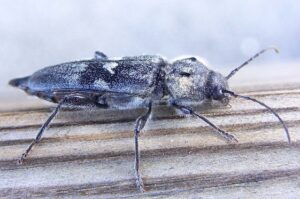
Credit: Siga |

Credit: CSIRO |
- Adults are 10-16 mm long, with an elongated, cylindrical body. Glossy black or dark brown with two patches of gray hairs on the flanks. Antennae of adults are long, reaching more than half the length of their body. On the pronotum two conspicuously hairless tubercles are characteristic of the species. On the elytra usually there are two whitish pubescent spots. Females do not have a real ovipositor, only a little more elongated telson.
- Larvae are yellowish-white in color, thoracic legless, and mature larvae can reach 30 mm.
Life Cycle and Common Characteristics
| · This pest prefers to infest softwood.
· Adults are most active in the summer (June–September). · The female lays her eggs in the cracks and openings of the wood. · Larvae pupate just beneath the wood surface (mid to late summer). |
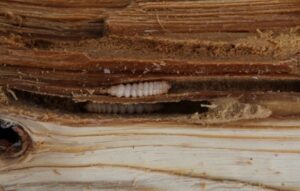
Credit: svajcr |
- Larvae turn into pupae and then into adults that remain for several months inside the tunnels before they exit from an opening (6–10 mm in diameter) that is considered the only apparent evidence of wood being infested with this pest.
- The life cycle from egg to beetle takes two to ten years, depending on the type of wood, its age and quality, its moisture content, and also depending on environmental conditions such as temperature.
Damages and Economic Implications
- Old house borers attack freshly produced sapwood of softwood timber.
- Contrary to the name “old-house borer”, the species is more often found in new houses; maybe because the beetles are attracted to the higher resin content of wood harvested more recently than 10 years earlier.
- If old wood is attacked, the damage is usually greater.
- Old house borers can be quite important as a scavenger of dead pine trees, pine fence posts, and similar objects, hastening their decay and collapse.
- Big-Headed Border, or Metallic Wood Borers:
Golden Jewel Beetle or Golden Buprestid
General Description
| · Adults are large (up to 20mm long), brassy green to golden beetle, with blue/purple highlights and coppery orange margins.
· They have elongated hard and flat bodies, nearly oval in shape, but tapered at the hind end into a point. · Five widely spaced ridges occur on each elytron. · They have serrate antennae.
|
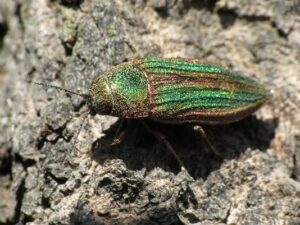
Credit: Katja Schulz |
Life Cycle and Common Characteristics
- In late spring or summer, the females seek out sites where they can lay their eggs in close proximity to wood, such as in bark crevices and scars.
- Eggs are laid singly or in masses, are surrounded by an adhesive secretion, and hatch soon afterward.
- The newly emerged larvae bore into the wood, usually 1 to 2 cm below the sapwood surface where they excavate mines that are enlarged as the larvae grow in size; occasionally, the heartwood is penetrated. Galleries are oval and flat, and packed with fine, light-colored frass. The walls of the galleries are finely grooved by the larvae as they feed.
- Larvae may cause varying degrees of damage, depending on the grain of the wood and the number and proximity of larval galleries. Detection of infested lumber before it is used in construction may be difficult as the flattened tunnels made by early-instar larvae are small (0.5 to 1.0 mm wide).
- Larval stage lasts 2 to 4 years.
- Mature larvae pupate at the end of the larval galleries during late summer, transform into adults in the fall, and overwinter in the galleries.
- In the following spring, adults chew through to the surface, leaving typical oval emergence holes. The foliage feeding causes no significant damage.
- The life cycle of the golden buprestid is so altered that the larvae may live up to 60 years and adults may emerge from the wood at any season.
- Adults are active from February to September, but most common from April to August.
Damage and Economic Implications
- Structural damage or noticeable wood destruction is rare.
- Wharf Borers:
Wharf Borer or Pavement Borer
General Description
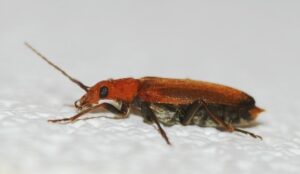
Credit: Alvesgaspar
Credit: Caroline Harding |

Credit: Alvesgaspar |
- Adults are around 1-1.2 cm in length, yellowish to reddish-orange in color. The whole body is covered with dense yellow frills and the antennae are more than half the length of the body.
- Eggs are creamy white in color, slightly curved with tapered ends.
- Larvae are creamy white, equipped with brown mandibles, and covered with brown bristles. The mouthparts and the tips of the oral palps are dark brown.
- Pupae are cream white and last 6–17 days.
Life Cycle and Common Characteristics
- Wharf borer adults may be present in different types of habitats but larvae are almost always restricted to damp, rotten wood. Buried pieces of wood may also harbor the insects.
- Females lay eggs in any damp, decaying timbers.
- The development time from egg to adult is about 12 months, and adults tend to emerge around June to late August.
- Eggs are deposited on wood surfaces where they are subjected to temperature extremes.
- Egg longevity is 5–11 days.
- First instar larvae burrow about 1 cm beneath the surface of the wood after hatching, where soft-rot type degradation is evident.
- Larva mainly feed on damp and decaying wood found along waterways and coastlines.
- The larval stage is reported to last from up to 2 -24 months, during which time larvae digest cellulose and hemicellulose.
- They emerge from the resting pupal stage between May and September.
- Adults are short-lived (2–10 days), non-feeding, free-living, able to fly and can locate wood via olfactory cues.
- Females are not substrate specific when choosing an oviposition site.
Damage and Economic Implications
- It is a household pest that infests very wet wood, such as in wood foundations adjacent to sewage or water connections, or rotten tree trunks
- Wharf borers are known to infest both hardwood and softwood.
- Adults can emerge from under the floor of buildings in quite large numbers, causing the occupants to think they may be being invaded by cockroaches.
- Adults are quite harmless.
IV – Fungi
- Outbreaks of dry rot and wet rot start in similar ways. The mature fruiting bodies of wood-destroying fungi that develop during an attack produce millions of microscopic spores that disperse by air currents. If they fall on untreated damp wood, they will germinate by pushing out a hollow tube called a hypha which grows and branches to form a mass of hyphal threads called mycelium.
- Mycelium develops on or within the wood and breaks down the wood for food. The timber may darken in color and can develop into the characteristic cuboidal cracked appearance of dry rot and a number of wet rots.
- The main differences between dry rot and wet rot are the degree of development of mycelium on the wood surface and the ability of the fungus to spread into other timbers via adjacent masonry.
- Fruiting bodies are far more common with dry rot than with wet rot.
Dry Rot
| · The mycelium of Serpula lacrymans develops extensively on the surface of infected timber and in still, humid conditions produces a mass of cotton wool-like growth with bright lemon-yellow patches.
· Mycelium spreads over the timber surface by the continued growth and branching of the delicate hyphal threads with time. Thicker strands develop within the mycelium and these supply water and nutrients to the growing front as the fungus · becomes established. · The fungus cannot derive any nourishment from the wall materials. · The ability of dry rot to spread into fresh timber has led to damage in new buildings. · Mycelium can grow out from the infected timber in the hardcore and can cause damage to skirting boards and other timbers before the wet-work construction dampness has dried out. |
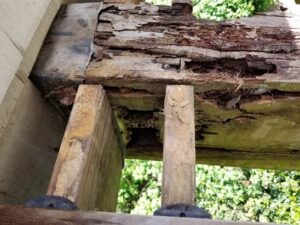
Credit: SFW Construction
|
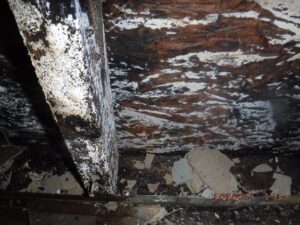
Dry rot with water damage Credit: SFW Construction |
Wet Rot

Credit: James Lindsey |
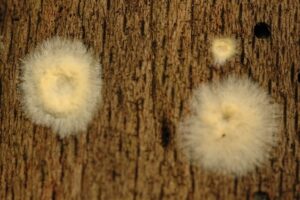
Credit: James Lindsey |
- Many different fungi produce decay known as white rot which is different in appearance.
- The most common fungi are: Coniophora puteana, Fibroporia vaillantii, and Phellinus contiguus.
- Wet rot is typically confined to the area of dampness because the mycelium does not spread into walls but in some instances may grow over masonry.
- In rare instances mycelium can develop extensively and some wet rot fungi produce strands.
V – Rodents (link to rodent section)


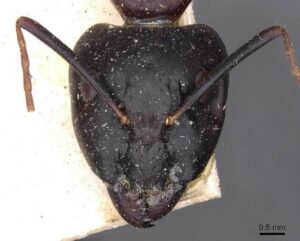
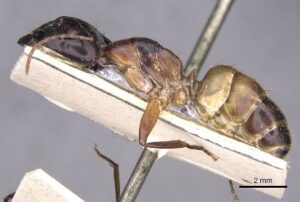
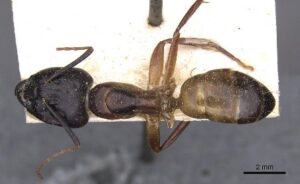
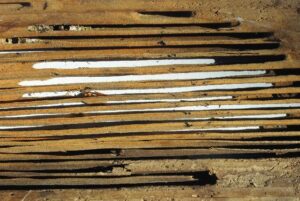 created galleries.
created galleries.